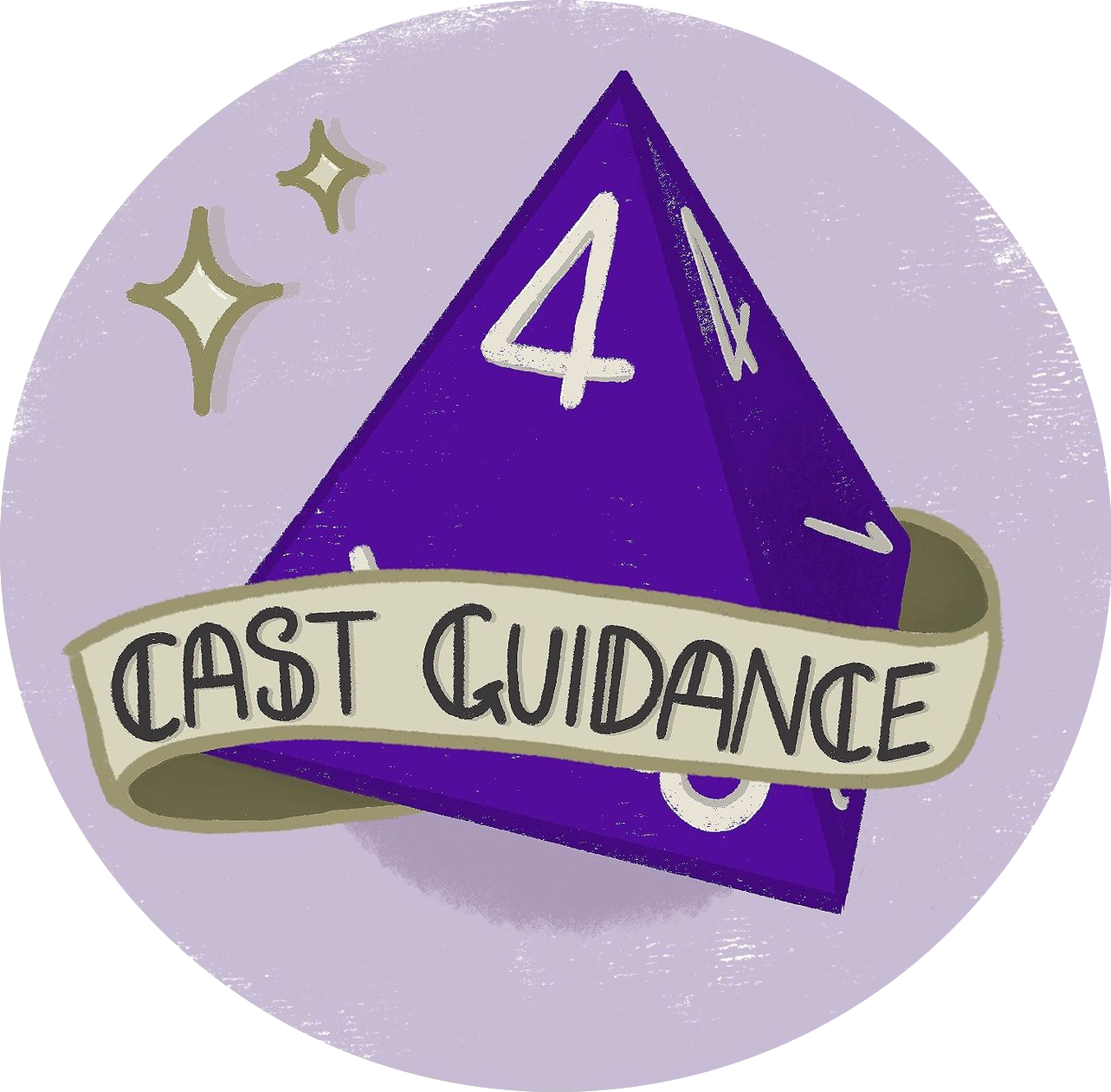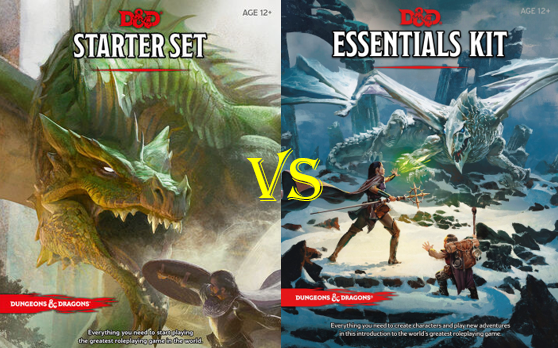Most people start playing Dungeons and Dragons because a friend has suggested they join their table. From that day onwards, the game takes over and sooner or later you will want to try your hand at being a Dungeon Master.
However there are some of us who had no one to help us. We picked up a beginners kit or a manual and studied the rules books page after page, because no one was around to ease us into the game.
To those of you who want to learn the game and have no one to help you, these kits can be a godsend, but are they really aimed at true novices, or are you expected to know the rules beforehand?
What’s In The Box?
A good beginners kit for any role-playing game should have a rule book, the items you need, and a clear direction for the narrator to stay on track. Luckily both sets have these qualities, so we are off to a good start.
Essential Kit
Inside the Dungeons and Dragons Essentials Kit, you will find:
- 11 Dice
- 6 Blank Character Sheets
- A 64 pages rule book
- Dragon of Icespire Peak Campaign – Preset Adventure
- Double-Sided Poster Map
- Dungeon Master Screen
- 81 Useable Cards (Magic Items, Sidekicks, Conditions, Initiative Numbers, and Sidekicks)
Starter Kit
Inside the Dungeons and Dragons Starter Kit, you will find:
- 6 Dice
- 5 Premade Character Sheets
- A 32 pages rule book
- Lost Mine Of Phandelver Campaign – Preset Adventure
The Box In Detail
Just by looking at the selection above, we can see that the Essential Kit has way more information and detail than the Starter Kit. But is detail what you need to understand the game?
Dice
The additional dice given to you in the Essentials Kits isn’t exactly “essential.” They include an extra 6-sided die, an extra 20-sided die, and what is known as the percentile dice. These dice are barely used in games, and although they can be helpful, they aren’t necessary to play the game. Almost none of the mechanic’s use those dice.
The Starter Kit is made up of one 4-sided, one 6-sided, one 8-sided, one 10-sided, one 12-sided, and one 20-sided. They are also blue instead of red. You need every one of these dice to play Dungeons and Dragons.
Character Sheets
As a new Dungeon Master and a new player, I struggled to understand how to create a character sheet. The proficiency bonuses messed me up, and when I leveled up my character, I left a lot of states on level 1.
The premade character sheets in the Starter Kit eliminate the worry about creating a “correct” character. It also shows what a sheet should really look like. The characters themselves are fairly average, so you know you shouldn’t be killed off in your first game.
If you have already played Dungeons and Dragons before, then you might feel constricted by a premade character sheet. In which case, you should be looking at the Essentials Kit’s blank sheet. Their rule books teach you how to build a character from scratch, and suggest what their backstory might be. The builds are still more limited than what the Player’s Handbook would give, but when you are new to DMing (Dungeon Mastering) these restrictions can help you stay on track.
Now that I know more about the games, I prefer to use DnD Beyond’s online character sheets. They do the math for you, level up your characters, and keep all your special features and spell descriptions in easy-to-find locations.
I have friends who prefer to play on paper; for them, the character sheets are easy to fill in once you know how proficiency bonus works.
Your bonus gets higher as you gain levels, and if your character is good at something (like using a bow), they can add these bonuses to their attacks. When your characters level up, you will need to create a whole new character sheet to adjust these numbers.
I think that new Dungeon Masters and new Players should start off with the Starter Kit’s premade character sheets to help them understand how to use the sheets and how to build them correctly.
Rule Books
The Players Handbook and the Dungeon Masters Guide are the main rule books in D&D for 5th Edition games.
5th Edition is the current edition of Dungeons and Dragons. You do not need to know the other editions to play.
In total, they are around 640 pages long. The 64-page rule book in the Essentials Kit has picked out the essential rules from these books, so you can learn the basics of the game without being confused by the flare of lore. But the rule book in the Starter Kit has been massively watered down and changed.
This elementary version of the rules is way easier to understand than the Essentials Kit. It basically holds your hand as it walks you through the rules, and it has stripped away the lore and confusion that new players often get overwhelmed by.
However, the Essentials Kit gives you a lot of information (granted, not 640 pages worth) and keeps all of the terminology and lore attached to the rules.
New Dungeon Masters will find the Essential’s rule book overwhelming, and when you think you’ve wrapped your head around it, you forget that the Wizards should have been “preparing” their spells all along.
Players who are not fresh off the page won’t find the Essential’s rule book a mind field. They have already played campaigns that touch on details like proficiencies and lore, so they might find the additional information helpful and insightful.
Preset Adventure
The Essentials Kit adventure gives a kind of “Monster of the Week” vibe. I won’t go into too much detail, as our detailed review explained the ins and out of the campaign.
First-time Dungeon Masters will have a hard time managing this story, as there are many NPCs (non-player characters) with unfinished backstories and desires just waiting around the game doing next to nothing. If you already know how to weave this type of dangling information into the story, then you won’t have a problem with these background characters, but most new Dungeon Masters will tie themselves into a knot trying to create a story for them to fit into.
The Starter Kit, however, is designed for the 5 premade characters the kit already gave you. The story is relatively short and doesn’t exceed level 5, and the game itself doesn’t go too far off track. There are some dangling NPCs that you should be wary of, but not so many that you’ll trip over your own creation.
Double-Sided Poster Map
The poster map is only available in the Essentials Kit, and although (again) it is not essential to play the game, it is a fun addition to draw you into the story. The map shows the adventure location and the zoomed-in drawing of Phandalin, the main town. The quality is excellent, but the map and the books don’t explain how long it will take your characters to get from one side of the map to the next.
The math isn’t hard, but the kit doesn’t explicitly tell you how far your characters can move in a day. Instead, I will explain it here.
On page 242 of the Dungeon Master’s Guide and page 32 of the Essential’s Rule Book, it is explained that “Characters can walk about 24 miles a day”. The map’s key says that 1 hexagon equals 5 miles.
This means that each character can move between 4 and 5 hexagons a day.
You can be creative here. Maybe it takes 4 hexagons to travel the roads, 4.5 to travel the grassland, and 5 to travel through the rivers, forests, and mountains. It’s this creativity that I want to avoid giving to a new Dungeon Master. Ideally, new DMs should understand the basics before being asked to fiddle with the rules like this.
Dungeon Master Screen
The DM Screen is a Dungeon Master’s best friend, and it is a big shame that the Starter Kit doesn’t include one.
It has all the basic and quick answers you might need while playing the game, including a size chart, a difficulty chart, condition descriptions, and much more. You can put the screen up, so your players cannot see your dice to allow the tension to grow, or you can stick helpful notes to the screen to remind you of those rules to just keep forgetting.
81 Useable Cards
Because most of my players use DnD Beyond, we didn’t find a need for physical handouts. We started playing in lockdown too, so my one paper-based player couldn’t receive her Potion of Healing card when she found it.
If you are playing in person and would like a physical handout, then these cards will be super helpful. They explain everything the item does, and they can fit into typical card holder pockets, thereby making searching for your items in physical form super easy.
Although I like to play online, I do think these physical handouts are a lot of fun and super useful, so it’s a shame that the Starter Kit does not include it as standard.
Can They Be Used Together?
Both the Starter Kit and the Essential’s Kit are based around Phandalin. They are not explicitly designed to be used together as the character levels will not match, however that doesn’t mean it’s impossible!
If you were to start off with the Starter Kit’s premade 5 characters and finish the campaign on level 5, you could start the Esseints Kit’s campaign and add in a couple of extra monsters to make the quests a little more challenging.
If you wanted to play the campaigns at the same time, this wouldn’t be a problem either. The stories mix well with each other, and this way, you don’t need to mess up the monster numbers to balance the encounters. However, mixing two campaigns like that might be a little complicated for a truly new Dungeon Master. This idea might be better saved for someone who has had a little more experience.
Which Beginner’s Pack Should A New DM Buy?
If you are a genuinely new Dungeon Master and you have never even played before, then the answer is obvious. You should pick the Starter Kit. It has just enough information for you to learn the game, but not so much that you get confused by all the nitty-gritty details. The premade character seems complex enough to be exciting but not so overwhelming that you’ll disconnect from the character or be unable to learn their actions. You get given all the equipment that you need and not a drop more.
If you have Dungeon Mastered before, or are an experienced player, then you should pick up the Essentials Kit first. The added Dungeon Master screen, the additional rules, the fleshed-out lore, and the ability to make up your own character sheets are enough to feel like you aren’t being babied. You already know a lot of the information on playing the game, so you don’t need a super watered-down version.
You could argue that the Starter Kit would still be an excellent kit for anyone to start with, but because of the missing screen and lack of handout cards, you will be missing out on a lot of fun and useful equipment. More knowledgeable beginners can benefit from those extras.
Whichever one you pick first, you should definitely buy the second kit after. The campaigns are great for every level, and they will fit perfectly into the world you and your players have already created. And who doesn’t love an extra set of dice!

